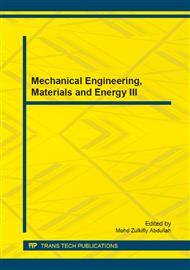[1]
X. C. Ding, M. Powers, M. Egerstedt, R. Young, and T. Balch: Eyes in the Sky: Decentralized Control for the Deployment of Robotic Camera Networks, Proc. IEEE, vol. 99, no. 9, (2011), pp.1541-1561.
DOI: 10.1109/jproc.2011.2158377
Google Scholar
[2]
D. Mellinger, N. Michael, and V. Kumar: Trajectory Generation and Control for Precise Aggressive Maneuvers with Quadrotors, The International Journal of Robotics Research, vol. 31, no. 5, (2012), p.664–674.
DOI: 10.1177/0278364911434236
Google Scholar
[3]
M. Ö. Efe: Integral Sliding Mode Control of a Quadrotor with Fractional Order Reaching Dynamics, Transactions of the Institute of Measurement and Control, vol. 33, no. 8, (2011), p.985–1003.
DOI: 10.1177/0142331210377227
Google Scholar
[4]
E. Altug, J. P. Ostrowski, and R. Mahony: Control of a Quadrotor Helicopter Using Visual Feedback, in Robotics and Automation, 2002. Proceedings. ICRA'02. IEEE International Conference on, vol. 1. (2002), p.72–77.
DOI: 10.1109/robot.2002.1013341
Google Scholar
[5]
D. Lee, H. J. Kim, and S. Sastry: Feedback Linearization vs. Adaptive Sliding Mode Control for a Quadrotor Helicopter, International Journal of Control, Automation and Systems, vol. 7, no. 3, (2009), p.419–428.
DOI: 10.1007/s12555-009-0311-8
Google Scholar
[6]
S. -J. Baek, D. -J. Lee, J. -H. Park, and K. -T. Chong: Design of Lateral Fuzzy-PI Controller for Unmanned Quadrotor Robot, Journal of Institute of Control, Robotics and Systems, (2013), 19(2): 164-170.
DOI: 10.5302/j.icros.2013.19.2.164
Google Scholar
[7]
M. Efe: Neural Network Assisted Computationally Simple PID Control of a Quadrotor UAV, IEEE Trans. Ind. Information, vol. 7, no. 2, (2011), p.354–361.
DOI: 10.1109/tii.2011.2123906
Google Scholar
[8]
S. Bouabdallah, A. Noth and R. Siegwart: PID vs LQ Control Techniques Applied to an Indoor Micro Quadrotor, in Intelligent Robots and Systems, 2004, Proceedings of IEEE/RSJ International Conference on, vol. 3, (2004), p.2451–2456.
DOI: 10.1109/iros.2004.1389776
Google Scholar
[9]
B. Erginer and E. Altug: Modeling and PD Control of a Quadrotor VTOL Vehicle, in Intelligent Vehicles Symposium, 2007 IEEE, (2007), p.894–899.
DOI: 10.1109/ivs.2007.4290230
Google Scholar
[10]
V. , J. , J. Fessl, and J. : Digital Self-Tuning Controllers, Spring, (2005), pp.90-137.
Google Scholar
[11]
R. W. Beard and T. W. McLain, Small Unmanned aircraft: Theory and practice. Princeton University Press, (2012).
Google Scholar


